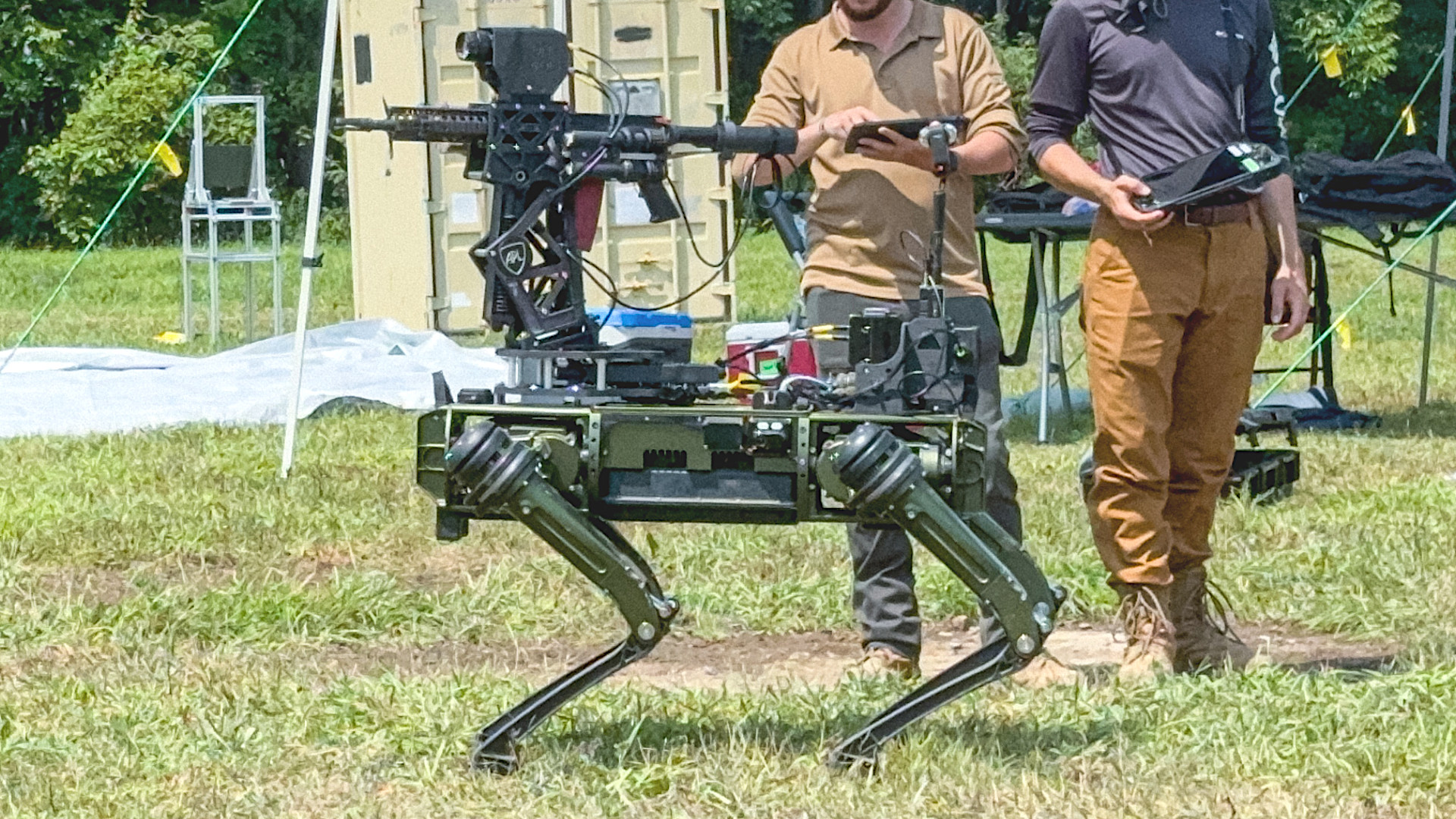A rifle-toting “robot dog” has become one of the latest additions to the ever-expanding array of concepts the U.S. military is exploring to help protect friendly forces from drones. Observations from the war in Ukraine and ongoing crises in the Middle East have provided renewed impetus for the acquisition of new anti-drone capabilities across America’s armed forces. Weaponizing robot dogs is also an area of growing interest within the U.S. military and elsewhere around the globe.
A Ghost Robotics’ Vision 60 quadrupedal unmanned ground vehicle (Q-UGV) armed with an AR-15/M16-type carbine is among the counter-drone capabilities being demonstrated at the U.S. Army’s Fort Drum in New York as part of what has been dubbed Operation Hard Kill. The Army’s 10th Mountain Division and the service’s Development Command-Armaments Center (DEVCOM-AC) are leading the event, which kicked off last month and is slated to wrap up this week.

Operation Hard Kill is “a live fire exercise” that “will establish Fort Drum as the premier training center in counter-UAS [counter-uncrewed aerial systems] through the demonstrated capabilities of lethal and non-lethal systems,” is how the Army described the event earlier this year.
From what can be seen of the Vision 60 Q-UGV taking part in Operation Hard Kill, the anti-drone configuration consists of a small turret on top of the front end of the robot dog on which the AR-15-type rifle is mounted. The gun has what looks to be a relatively large electro-optical targeting system (with “Lone Wolf” written on the side) on top with a large objective lens. This points to an infrared/thermal vision capability, something that is especially useful for finding targets in the sky. There is also a laser aiming device attached to the side. A GoPro-like video camera appears to be mounted on a mast at the rear end of the Q-UGV, as well.

A video the Army has released from the event, seen earlier in this story, also looks to show individuals using tablet-like devices to control the gun on the robot dog remotely. Whether or not the complete system provides for cueing from offboard sensors is unknown, but some degree of automated targeting would be highly preferable in the counter-drone role. The SMASH series of computerized gun sights from Israel’s Smart Shooter is a prime example of small arms optics on the market now that offer target recognition and assisted aiming functionality, and that can be used in a remotely-operated configuration. SMASH variants are already being fielded to a limited degree by multiple branches of the U.S. military and their use looks set to grow.

The turret assembly also bears the logo of Johns Hopkins University’s Applied Physics Laboratory (APL), which has a long history of supporting U.S. military advanced research and development efforts, including through rapid prototyping. The War Zone has reached out to APL for more information about this anti-drone robot dog.
The C-UAS-configured Vision 60 looks to be well in line with pushes by the U.S. Army and U.S. Marine Corps to expand anti-drone capabilities down the lowest levels of their force structures. The War Zone has highlighted many times in the past how robot dogs offer ideal platforms for scouting ahead and providing localized security, especially in support of small units in dense urban environments, just like their real live counterparts.

In the counter-drone role, a robot dog could leverage its ability to get in and out of spaces that might be inaccessible to a human to help get a better vantage point or expanded field of fire to protect against incoming uncrewed aerial threats. This would also allow friendly forces to engage hostile drones while remaining behind cover.
None of this is to say that a drone-hunting robot dog armed with an infantry-type rifle would be a complete solution to the threats posed by uncrewed aerial systems in itself. The Army and Marines, as well as other branches of the U.S. military, are envisioning a future with broader layered anti-drone defenses.
The images and videos that the Army has released from Operation Hard Kill show other counter-drone capabilities being demonstrated. This includes the Containerized Weapon System (CWS), which can be configured for counter-drone use using laser-guided 70mm rockets as its effector, as well as with Javelin anti-tank missiles and other weapons for employment against threats on the ground, as you can read more about here.

A version of the Rheinmetall Mission Master uncrewed ground vehicle with a turret armed with a pair of fast-firing 7.62mm Miniguns, which was first unveiled back in 2022, is also being demonstrated at the event at Fort Drum. This reflects a separate trend in the development of counter-drone configured UGVs, some of which are also equipped with small radar arrays and other sensors.

Any rifle-armed robot dog could be employed against other targets besides drones, as well. Marine Forces Special Operations Command (MARSOC) has been evaluating Ghost Robotics Vision 60s armed with rifles and conventional Marine units have been testing other types of robot dog types equipped with anti-armor rocket launchers.

Multiple types of unarmed robot dogs are already in limited U.S. military service in multiple roles, including to help with perimeter patrols around friendly bases.

Armed robot dogs look to be increasingly on the horizon for U.S. forces, including now potentially as a way to help hunt down hostile drones.
Contact the author: joe@twz.com
